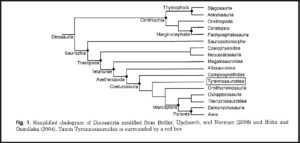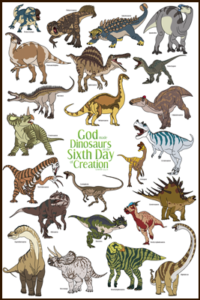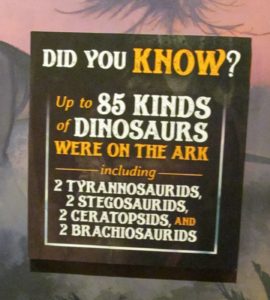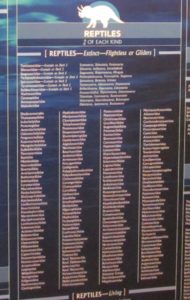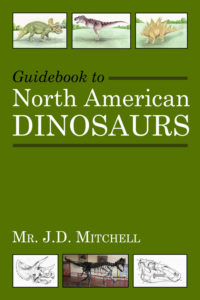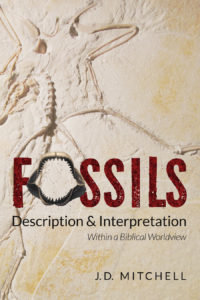This article is the second of two on dinosaur kinds. It is designed to be read after article one which can be found here. The first article focused on some dinosaur classifications based upon secular presuppositions of evolution and millions of years. This article will look at some creationist dinosaur classifications that have a foundation based on a literal understanding of the Bible. The primary biblically-based presuppositions are that God created dinosaurs along with the rest of the animals and man on Day six of the creation some 6,000 to 6,200 years ago; and that the dinosaur fossils found in the sediments of the earth are as a result of a global Flood some 1,600 years after the Fall and institution of the curse. This year-long worldwide Flood took place about 4,500 years ago at the time of Noah.
Evolutionists always classify dinosaurs assuming similarity between different varieties is due to common ancestry. Creationists accept the biblical pronouncement that dinosaurs were created by God according to kinds and that, therefore, common design overrules the common ancestor argument when classifying dinosaurs and all lifeforms except humans. The Bible says mankind was not created according to kinds but in the image of God.
A. CREATIONIST DINOSAUR CLASSIFICATION—by Brian Thomas and Tim Clarey from the Institute for Creation Research (ICR)
This dinosaur classification is found in several publications from ICR authors. In their book, Guide to Dinosaurs [ICR, ©2014], the authors state, “This table lists the accepted dinosaur suborders, infraorders, and families.” The table follows in my Figure 1 below.
Figure 1: ICR Dinosaur Classifications per Thomas and Clarey
I am confused by the previous statement for two reasons. Firstly, it is not stated who has decided that this is the “accepted” classification. In my Part 1 article I concluded that there is no consensus among secularists regarding dinosaur classification. Do Thomas and Clarey mean that this classification in Figure 1 above is accepted by them? It does have a lot of similarity to the “Discover Dinosaurs” poster we looked at in Part 1, but it is not exactly the same, and does not match up at all to the other secular systems we analyzed. Secondly, Figure 1 does not include dinosaur families, so why do they say it does. It shows two orders, five suborders, and 13 infraorders. They do add in the text that there are “60 accepted families of dinosaurs, and a family may approximate a kind.” So, to begin with there seem to be some serious discrepancies in this chart.
Notice that this chart is similar to the “Dinosauria” chart in Part 1 in that it shows a tree of life path from left to right. The only thing different in design between the two is that there is no timeline attached to the ICR classification chart. I must assume that their “accepted” chart was arrived at by someone’s cladistic analysis; and that is my greatest concern for this creationist classification because, as I have stated numerous times, cladistics, by definition, assumes evolution.
So, how did Thomas and Clarey utilize their chart in their Guide to Dinosaurs book? Well, they discuss each of the five suborders separately and then a number of the more common dinosaur genera within each suborder. I do not have any major issues with most of the contents of their book excepting for the concerns about their classification that I discussed in the paragraphs above. I don’t totally agree with their explanation for Archaeopteryx, however.
B. CREATIONIST DINOSAUR CLASSIFICATION—Dinosaurs-Marvels of God’s Design by Dr. Tim Clarey, ©2015
This book was published shortly after the previous book by Thomas and Clarey. The newer book has the exact same dinosaur classification chart as that book as seen in Figure 1. Again, Clarey says, “Dinosaurs are presently divided into orders, suborders, infraorders, and families. There are only five accepted suborders, 13 infraorders, and 60 families of dinosaurs. A family seems a reasonable approximation of a kind.” [See page 22.]
So, we see again that word, “accepted,” and again without any reference to source. I am sure Clarey does not in any way support cladistic analysis as valid and has quite a bit to say about its inadequacies in his book. But, still the question remains, how did he determine how dinosaurs are classified? On page 26 of his book he shows a dinosaur classification cladogram shown in Figure 2 below. It does not match up to his tree shown in Figure 1, and so must not be where he got the “accepted” classification. I am also sure Clarey does not accept that birds evolved from dinosaurs!
Figure 2: Sample Evolutionary Cladogram from Clarey’s book on Dinosaurs
Dr. Clarey’s treatment of the different kinds of dinosaurs in the 2015 book is very similar to that of the Thomas and Clarey 2014 book. The emphasis in both books is on various dinosaur facts about dinosaur kinds at the genus level. This is the way almost all dinosaur books, whether secular or creationist, handle dinosaur details intended for consumption by the general public.
C. CREATIONIST DINOSAUR CLASSIFICATION—“Discerning Tyrants from Usurpers: A Statistical Baraminological Analysis of Tyrannosauroidea Yielding the First Dinosaur Holobaramin,” by M. Aaron [Answers Research Journal 7 (2014):463-481.]
This paper is focused on dinosaurs like Tyrannosaurus and used the creationist method called baraminology to attempt to classify dinosaur within just that Tyrant Bipedal kind of dinosaurs. Baraminology is defined to explicitly use creationist assumptions and criteria. Generally, a baramin is what the creationist would consider to be a created kind. A holobaramin is defined as a group of organisms within which every member shares continuity with at least one other member. I think the paper is helpful as an early attempt to classify dinosaurs using creationist methodology. Here in Figure 3 is the cladogram chart that author Aaron used as the foundation for the analysis:
Figure 3: Cladogram used by Aaron for Baraminological Analysis
I am not commenting here on the specific conclusions that author Aaron came to in this paper. I just want to remind the reader that cladograms always assume evolution. My question is: Can a baraminological analysis based on cladistics properly represent creationist presuppositions?
D. ANSWERS IN GENESIS—Determination of dinosaur kinds for Ark Encounter Project
I will begin this section with the two Answers in Genesis (AiG) posters seen in Figures 4 and 5. Each poster has the title, “God Made Dinosaurs on the Sixth Day of Creation.” There is a blue poster with 24 dinosaurs illustrated and identified on it and a green poster with 23 dinosaurs. Answers in Genesis does not promote the idea, as we will see later in this section, that the created kind was at the genus level of taxonomy, but each of these 47 poster dinosaurs is a genus name. So it would be logical for the uninitiated to assume that AiG is promoting that at the end of the sixth day of creation these 47 dinosaurs existed. I wonder how many people have been led by these posters to believe that creationists think they represent created kinds of dinosaurs.
Figure 4: AiG Blue Dinosaur Poster
Figure 5: AiG Green Dinosaur Poster
Answers in Genesis scientists began research in 2011 to determine which land and flying animals they would show as being the kind that God brought to the ark prior to the Flood. This was a part of the research needed prior to the outfitting of their fantastic Ark Encounter attraction. A position paper, “Determining the Ark Kinds” was published in 2011 stating how they would determine the ark kinds on the Ark Encounter. The abstract for this paper reads in part as follows: “…hybridization will be considered the most valuable evidence for inclusion within an ‘Ark kind.’ The cognitum and statistical baraminology are discussed as they are relevant to this venture. Where hybrid data is lacking, we have chosen to use a cognitum method. Using current taxonomic placement as a guide, pictures and/or personal experience with the animals will be used to find obvious groupings…the family level may be used as the default level…” [Answers Research Journal 4 (2011):195-201.]
Since the position paper was written, several other papers on ark kinds have been written by members of the research group. They are as follows:
1. Mammals in 2012 by Lightner.
2. Frogs in 2013 by Hennigan.
3. Birds in 2013 by Lightner.
4. Turtles and crocodiles in 2014 by Hennigan.
5. Tuatara, Amphibians and snakes in 2014 by Hennigan.
6. Non-snake and non-amphibian lizards in 2015 by Hennigan. [All articles can be found in the Answers Research Journal available for free on the AiG website.]
Notice that all of these animals are extant. The analyses were done using hybridization first and cognitum next. I have not found any papers by this AiG research group on the dinosaur ark kinds, but we can know for sure that when AiG chose the dinosaur ark kinds for the Ark Encounter they would not have been able to use the hybridization method since there are no dinosaurs today to observe. So, I am assuming that they used some sort of cognitum method for the dinosaur kinds on the Ark Encounter.
What, exactly, is the cognitum method? Here is the basic explanation from the 2011 paper: “A cognitum is a group of organisms that are naturally grouped together though human cognitive senses. A cognitum can be above the level of the baramin, below the level of the baramin, or at the level of the baramin.” For more detail on this the reader should go to the original paper.
I want to stress that it is highly unlikely that the ark kinds would be exactly the same as the created kinds. There were 1,600 years of time for much variation within kinds between the creation and the Flood.
So, what are the ark kinds for dinosaurs on the Ark Encounter? In 2019 I visited the Ark Encounter and took some photos of interpretive signage that should help answer this question.
Figure 6: Ark Encounter Sign about Dinosaur Kinds
So the sign in Figure 6 says up to 85 kinds! That is more than the 43 genera on the posters. That is more than the 60 created kinds that ICR endorses. Did the Ark Encounter signage provide any additional help? There is also a large interpretive board showing the Ark Kinds that has the dinosaurs categorized as an extinct reptile.
Figure 7: Ark Encounter Extinct Reptiles Signage
I am not familiar with some of the animal kind terminology on this display sign, and I do not agree that all dinosaurs were specifically reptiles, so I cannot perfectly interpret this sign for you. I counted 195 reptile names in this section of the currently extinct ark kinds listing. I recognize many of them as dinosaur names, but some I do not recognize at all. I would be hard pressed to reduce the names on the sign down to the 85 dinosaur kinds mentioned in Figure 6.
E. CREATIONIST DINOSAUR CLASSIFICATION—MITCHELL DINOSAUR KINDS
Here is the final creationist dinosaur classification method examined in this article. If the statements of the Bible are accepted as true, then we can know that God created the dinosaurs along with the rest of the animals (and man) on Day Six. We can also know that the dinosaurs were created according to kinds and did not evolve from a “common ancestor.” It makes sense that each dinosaur kind would have had an essence, that is, a basic identifying nature. Just as even a small child can tell that horses, dogs, cats, elephants, hippos, and humans are all different kinds, that essence of difference would have clearly separated the various kinds of dinosaurs as well. We would also know that birds are not dinosaurs since the Bible tells us that birds were created on Day five ahead of the dinosaurs that were created on Day six.
From the Bible we also can know that about 1,600 years after the institution of the curse, God brought a cataclysmic Flood that destroyed the entire surface of the earth. God brought this global disaster not only because was man corrupt, but the “entire earth was corrupt and filled with violence.” Only the land animals brought to Noah’s ark by God lived to attempt to repopulate the earth after the Flood. And, the next point is important to remember, there is no reason to believe that the kinds that God brought to the ark were exactly the same at the created kinds that God made in the beginning. Did Noah and his family have the same genetic makeup as Adam and Eve? I think not due to 1,600 years of the effects of the curse. And this same effect would have been applied to the animals including the dinosaurs. This fact is reflected in the science listed below:
1. Measureable variation within a kind can occur quite rapidly.
2. Variation within a kind has not been, and cannot be, demonstrated to lead to evolution of one kind to another kind.
3. Variation within a kind can be quite extensive, but has definite limits.
4. True transitional fossils showing one kind evolving into another kind have not been found, and there is no scientific reason to believe they exist.
5. Fossil lifeforms are in many cases identical or very similar to modern lifeforms. These are called “living fossils.”
6. Many dinosaur species and genus names have been applied based on inadequate remains, such as teeth or a few bones. Therefore, many names are invalid and many others are the result of the tendency for paleontologists to be taxonomic “splitters” instead of “lumpers.”
Keeping all of the points in the above three paragraphs in mind; it should be possible to study fossil dinosaur remains while looking for the essence of a number of dinosaur kinds, without using cladistics. That way a classification system for dinosaurs could be proposed that does not assume macroevolution. This is what I did while developing the material for my book, Guidebook to North American Dinosaurs According to Created Kinds (GNAD). I realize that this method of classification could be considered as cognitum. I had never heard of the word at the time that I published my book.
For example, let us look at the dinosaurs usually included in the Ceratopsia grouping. In GNAD there are 18 genus names included in my proposed dinosaur created “Kind #5—Horn-Faced Dinosaurs.” Three of the 18 listed are genera Triceratops, Chasmosaurus, and Styracosaurus. An inspection of the fossils reported for these 18 genera finds that there is little variation between these animals excepting for their skulls. That is, for all the genera in GNAD Kind #5, their skeletons are very similar. In the image below models of the skulls are shown for the three genus names mentioned, and a lot of similarity can also be seen in the skulls.
Figure 8: 1/10th size Models of Triceratops, Chasmosaurus, Styracosaurus Skulls—Horn-Faced Dinosaur Kind
By assuming that the differences found in the fossils for the dinosaurs in these 18 genera are due to dimorphism, age at death, lifetime injury or disease, genetic changes, and the damage to the fossils from the ravages of the Flood, it makes sense to combine them into one created kind. For the dinosaur fossils found in North America, I was able to lump over one hundred genera into 15 kinds, as seen below and as found in GNAD. The dinosaur fossils I used in this analysis were largely from those I found in museums I visited in North America.
Figure 9: Mitchell’s 15 Created Kinds of North American Dinosaurs
I believe my system of dinosaur classification is the only one described in this article that clearly does not rely on cladistics and an assumption (possibly unintended) of evolution for the data. I think that the homology obvious in dinosaurs indicates the intelligent engineering involved in each kind and does not indicate common ancestry as is assumed by cladograms.
Finally, I hope these two articles are informative for those interested in dinosaur classification ideas. As mentioned in the beginning of Part 1, I do not expect that these two articles will necessarily convince many people to change their minds about the subject. You undoubtedly can tell my position regarding the best current dinosaur classification proposal. If you would like to learn more about the Mitchell Dinosaur Kinds for North America, as well as my take regarding Archaeopteryx, you can order the books shown below by clicking on the images.
J.D. Mitchell


